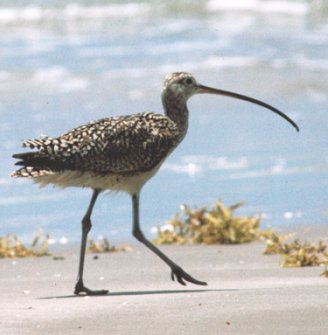Long-billed Curlew (Numenius americanus)

TPWD ©
- Description
- The long-billed curlew reaches a height of 18 to 26 inches (45 to 66 cm), with a 36- to 40-inch (91 to 101 cm) wingspan. They have speckled brown and buff backs and upper wings, buff colored bellies and breasts, and cinnamon-colored underwings. Their legs and feet are bluish-gray, and the feet have webbed front toes. The long, thin, down-curved bill is dark and fades to a flesh tone at the base. Its bill can be more than 8 inches (20 cm) long and has a droplet-shaped tip.
- Life History
- When inland, long-billed curlews eat mostly insects and worms. In coastal areas, they probe in the mud with their long bills for shellfish, crabs, and fish. They will also eat other nesting birds. Predators hawks, badgers, coyotes, weasels, and snakes feed on long-billed curlews. Sexual maturity is reached at three to four years. Mating season is from mid-April through September. Nests are built on the ground in flat, open areas with clumps of grass. The nests are simple depressions in the ground, usually lined with grass. Females typically lay four greenish or buff-colored, pear-shaped eggs with brown spots, which incubate for 27 to 30 days. The chicks can fly within 45 days of hatching. Life span is up to ten years.
Curlews frequently build nests near cow patties or bushes to help hide the nests from predators. The females incubate the eggs during the day and the males incubate at night. The females will abandon the nest and their mate two to three weeks after the eggs hatch. Predators destroy 10 to 16 percent of long-billed curlew nests. If a nest is only partially destroyed, the parents will still abandon the remaining eggs.
Long-billed curlews are also called "sicklebills", "big curlews" or "hen curlews." The genus name, Numenius, is Greek and refers to its crescent-shaped bill. Long-billed curlews can swim if they need to - their front toes are webbed. They can fly as fast as 50 miles (80 km) per hour. - Habitat
- Long-billed curlews prefer prairies and pastures with short grass during breeding season. After breeding, they seek seashores, lakes, rivers, mudflats and salt marshes.
- Distribution
- Long-billed curlews can be found from southwestern Canada to the western half of the United States. They winter in the southern United States and south to Guatemala, but can be found along the Texas Gulf Coast during the summer as well.
- Other
- Not surprisingly, the long-billed curlew has a long, downward curving bill. Look for it on the seashore where it spends its winters or in fields and prairies where it breeds. Habitat loss has forced it to exist almost exclusively in the western half of North America. The long-billed curlew was once common along the Great Plains and in the eastern United States. In the late 1800s and early 1900s, these and other shorebirds were hunted in large numbers as game; long-billed curlew was a menu item in many restaurants. By the time they were finally protected by the Migratory Bird Treaty Act, much of their crucial breeding habitat had been destroyed for agriculture. Populations in the eastern United States never recovered, but curlews remain fairly common in the western United States. Although pesticides may have also contributed to declining populations of curlews, the main reason for the species' continued decline is habitat loss. The long-billed curlew is listed on the Audubon Society's Blue List of decreasing bird populations. It is also listed as endangered, threatened, or species of special concern in several states.